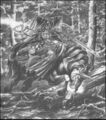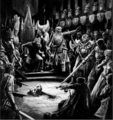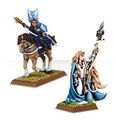Lady of the Lake
The Lady of the Lake (AKA. That lying bitch!) is the patron Goddess of the Bretonnia army in Warhammer Fantasy. She demands nobility, honour, courage, and absolute steadfast approach to all things. In order to even BE nobility in Bretonnia, you must dedicate yourself to her (simple enough) and join the Knight Errantry after your squireship ends. Those who actually want to be somebody someday will eventually (temporarily) forsake their titles and property, becoming Questing Knights looking to wander the world and prove themselves to the lady. Those who impress her earn a boon; she appears before them holding a magical chalice, and after they drink from it, they find themselves buffed to demigod levels of strength. The knights who accomplish this are known forever more as Grail Knights, supreme badasses who it would not be unfair to call the Space Marines of Warhammer Fantasy. Of course, most Questing Knights die in the process (also like Space Marines).
History[edit]
For years The Lady was thought by the playerbase to simply be Ariel, the queen of the nearby Wood Elves manipulating the Bretonnians into doing their bidding. However, 8th edition confirmed that she is indeed a separate entity; possibly Elvish, the Wood Elves call her "Corrigyn, The Daughter of Mist". It's theorized by some that she either is or is the daughter of the Elf goddess Ladrielle who is also connected to mist. The End Times revealed she was in fact Lileath (who Ladrielle was confirmed to simply be an aspect of), and that her Damsels and Grail Knights would form the human pantheon in the new world.
She is described as having a home on the Silverspire; in the End Times, she takes the formerly-current king of Bretonnia, King Louen Leoncoeur, there to be her husband.
While she only appears before Questing Knights who prove themselves worthy, the Lady still maintains an active role in the lives of her worshipers. She chooses a mortal servant, always female, from the Bretonnian nobility called the "Fay Enchantress". The Enchantress sends messages to the nobility, and keeps an honored position in the king's court. The Fay Enchantress has supreme authority in the kingdom as her word is the word of the goddess and has in the past stripped nobility of their rank and possessions and had them exiled without question (with the Grail Knights doing the heavy lifting).
Any child born with magical talent in Bretonnia is visited by the Fay Enchantress upon reaching puberty. Before this time, some children are sent to the Empire to be taught magic in the Colleges of Magic. The rest are taken by the Enchantress to the "Otherworld" of which nothing is known. Culturally they are treated as dead, and the males never return from what the Bretonnians assume is a happy ending (a Black Library short story eventually made the claim that the collected boy-mages are essentially press-ganged into the “Sons of Bretonnia”, an order of Grail Knights-lite with glowing skin, silver armor, and limited spellcasting ability that spend all their time fawning around the Lady like the elvish equivalent of a Japanese butler cafe, with occasional forays into helping their countryman fend off especially nasty Tomb King invasions or threats of similar scale.) Female children sometimes return however, and are known as Damsels or Prophetesses. They speak little of what they've seen and done, although they claim to have been trained by "Handmaidens of the Lady" in their magics. While they cast spells like ordinary Wizards might, their magic is primal; safer to cast due to coming from something not of the the powers of the Warp and reverse-corrupting what the Warp touches. Their magic is directly from the Lore of Life, although like the magic of the Queen of the Elves is not the type of Life that Wizards can use and wield via study. They are unapproachable in society, serving as advisers to nobles or tenders of the Lady's sacred sights as she sees fit to send them.
The current Enchantress is named Morgiana Le Fay, and in the End Times she was converted to vampirism then sacrificed to resurrect Nagash (possibly, as it is only mentioned in one of the two sources of the event).
If you didn't realize it by now, she's directly and unashamedly inspired from Arthurian myth. Except this time she's all over the French. (despite in Arthurian legends, the Lady of the Lake was in Northern France anyway,which makes sense since "Lancelot Du Lac" means "throws water of the lake" in French)
Tenets[edit]
According to "Knights of the Grail", a Bretonnia splatbook for Warhammer Fantasy Roleplay 2nd edition, the Lady has two sets of tenets; the one everybody knows is the Bretonnian code of chivalry, which is for men, whilst she has another one for women. Although keep in mind that this is the same book that says that worship of the Lady is primarily a thing amongst the nobles of Bretonnia, the dominant peasant religion is Shallya, and that there's a pernicious heresy amongst peasants that the Lady is actually a servant of Shallya's sent to guide the nobles to treat peasantry better - the Grail Knights and Damsels try to stamp this out wherever they hear about it, but it keeps popping up.
It doesn't directly list the tenets of the religion as it applies to men, instead talking about how it revolves around trying to attain and uphold three ideals; Valour, Loyalty and Courtesy. But, it does give the direct tenets for women, and they go as follows:
- Preserve your modesty and innocence.
- Serve and obey your father before marriage, your husband after.
- Succor those who are weak and helpless through no fault of their own.
- Show favor only to the bravest and most noble knights who seek your blessing.
Religious Rivals[edit]
The army books usually treat the Lady of the Lake as the exclusive goddess of Bretonnia, in a fashion that is at least Sigmar like if not truly monotheistic. The aforementioned Knights of the Grail splatbook for Warhammer Fantasy Roleplay instead asserts that the Lady merely fills a Sigmar-like role as "The God of the Nobles"; the lords of Bretonnia worship her exclusively and above all, but the commoners instead worship a slightly modified version of the Imperial pantheon.
- Shallya is the supreme goddess amongst peasant folk, who dedicate themselves to receiving her kindness and compassion in much the way that the lords venerate the Lady.
- Taal and Rhya are also important to peasants, since they make their lives around farming and hunting; many outlaws also worship Taal as their patron god.
- Morr is respected by both peasants and nobles, and has responsibility for tending to Bretonnia's graves.
- Manann, as God of the Sea, is as important to Bretonnian sailors and fisherfolk as he is to Imperial ones.
- Ranald is popular with the merchants of Bretonnia, to the point he's considered a God of Merchants and Traders more than a God of Thieves... not that the average Bretonnian sees much difference between a merchant and a thief.
- Verena is worshiped by Bretonnia's few scholars, as well as by some of the Herrimaults, the Bretonnian equivalent of Robin Hood and his Merry Men.
- Myrmidia has a slowly growing cult amongst the peasant militias raised by the nobles, although her association with foreign mercenaries is impeding her spread.
- Ulric is all but unheard of, and Sigmar has no worshipers whatsoever due to them being seen as the Empire's patrons.
Gallery[edit]
-
The Lady in Bretonnian art.
-
A canon appearance of the Lady.
-
Another canon appearance.
-
A Fay Enchantress.
-
Morgiana in artwork.
-
Morgiana's old model.
-
Morgiana in the king's court.
-
Artwork of a Damsel.
-
Damsel models.








